Dane.Kouttron
[9.14.16] ALUMINUM BOAT
UPGRADES
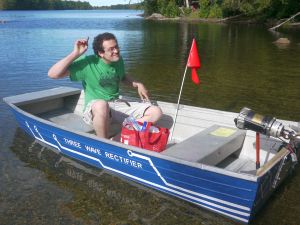 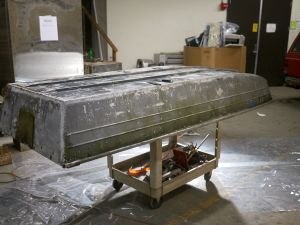 The
following details the repair and rejuvenation of a
relatively low cost aluminum row-boat. Nicknamed 'jon
boats', this shape craft are super low maintaince and
fairly lightweight. The aluminum also allows them to be
recyclable, whereas fiberglass boats end up requiring
elaborate repair / reuse processes. This page documents
the cleaning, de-painting, riveting, epoxy coating and
painting of an 8 ft aluminum 'jon' boat. The
following details the repair and rejuvenation of a
relatively low cost aluminum row-boat. Nicknamed 'jon
boats', this shape craft are super low maintaince and
fairly lightweight. The aluminum also allows them to be
recyclable, whereas fiberglass boats end up requiring
elaborate repair / reuse processes. This page documents
the cleaning, de-painting, riveting, epoxy coating and
painting of an 8 ft aluminum 'jon' boat.
Behold the "THREE WAVE
RECTIFIER" |
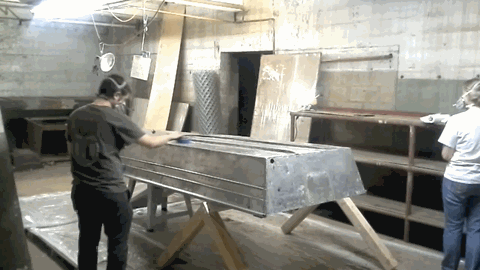 Epoxy
time ahoy! Epoxy
time ahoy!
Pulling all the old
paint and scum off was fairly intense, going from
'greenish hints of algae to two-part sealing primer
was a time consuming process. Shown here is the first
layer of primer being applied. A julian appeared halfway through
the process to observe the gloriousness. |
The Craft awaiting a new
life
|
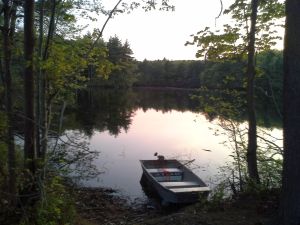  The
return of 8' Jon Boat The
return of 8' Jon Boat
Last
episode we took the craft out with the
experimental 1kw dc thruster. This boat was a heavily
used 'craigslist deluxe' craft and a bit sketchy in
terms of flotation. The main qualm was while the
vessel was structural there were a number of slowly
leaking rivets and an odd 'wood screwed into wood'
plug for the rear drain port. |
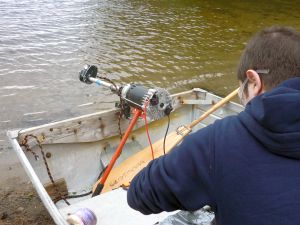 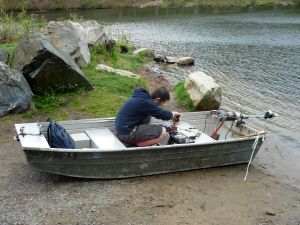 The craft's paint was
wearing off and it appears a previous attempt at
covering leaky rivets was also showing through. The
transom itself was riddled with rusting bolts and
starting to become less, er, structural. Time for some
summertime upgrades! The craft's paint was
wearing off and it appears a previous attempt at
covering leaky rivets was also showing through. The
transom itself was riddled with rusting bolts and
starting to become less, er, structural. Time for some
summertime upgrades! |
De-Painting
|
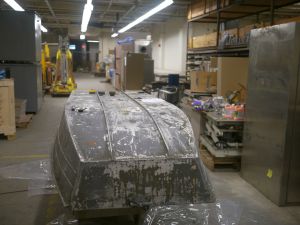  The craft itself had seen
better days, from the initial test, with the 1kw dc
thruster, it was a tad leaky, the outboard
mount was a mostly rotted plywood sheet and the
outside was covered with patches of sad paint and
'biological stuff'. The craft itself had seen
better days, from the initial test, with the 1kw dc
thruster, it was a tad leaky, the outboard
mount was a mostly rotted plywood sheet and the
outside was covered with patches of sad paint and
'biological stuff'. |
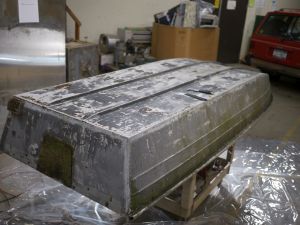 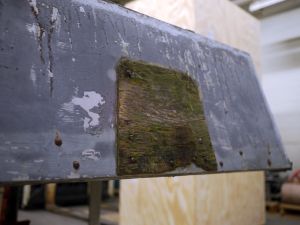 Plywood in a marine
environment didn't survive, at all. It peeled off
fairly easily. Removing the transom and backplate were
incredibly straight forward, the bolts quite literally
broke in two when yanked on. Plywood in a marine
environment didn't survive, at all. It peeled off
fairly easily. Removing the transom and backplate were
incredibly straight forward, the bolts quite literally
broke in two when yanked on. |
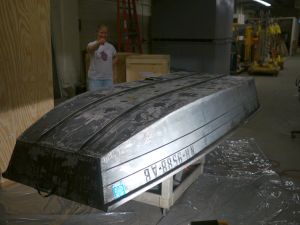  A good space to work. The
stripping process is messy, the paint that gets
removed needs to go somewhere. For this, an unused
garage bay did the trick, I purchased 14' square
painting sheeting and taped it to the floor to act as
a 'goop pickup' scoop. It worked fairly well. The boat
itself was raised from the ground and ratchet strapped
to a cart. This allowed the stripper application and
paint scraping to occur up in the air versus bent over
on the ground. A good space to work. The
stripping process is messy, the paint that gets
removed needs to go somewhere. For this, an unused
garage bay did the trick, I purchased 14' square
painting sheeting and taped it to the floor to act as
a 'goop pickup' scoop. It worked fairly well. The boat
itself was raised from the ground and ratchet strapped
to a cart. This allowed the stripper application and
paint scraping to occur up in the air versus bent over
on the ground. |
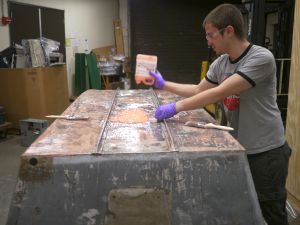 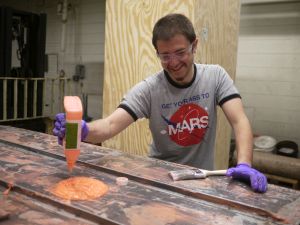 The De-painting began
with an environmentally friendly Citri-Strip QCG73801T
stripper. It's available [link] and purports to be non
toxic. I was mostly concerned with the stripper eating
through the aluminum on the boat. About two containers
of goo were used to begin the stripping process.
Paintbrushes were used to spread the goo and form a
layer over all of the boat surfaces. The ever
excellent Sam helped make this possible, as there's
quite a bit of boat to cover with only one set of
hands. Note, gloves were mighty useful during the goo
spreading. I think we burned through a dozen sets of
gloves. The De-painting began
with an environmentally friendly Citri-Strip QCG73801T
stripper. It's available [link] and purports to be non
toxic. I was mostly concerned with the stripper eating
through the aluminum on the boat. About two containers
of goo were used to begin the stripping process.
Paintbrushes were used to spread the goo and form a
layer over all of the boat surfaces. The ever
excellent Sam helped make this possible, as there's
quite a bit of boat to cover with only one set of
hands. Note, gloves were mighty useful during the goo
spreading. I think we burned through a dozen sets of
gloves. |
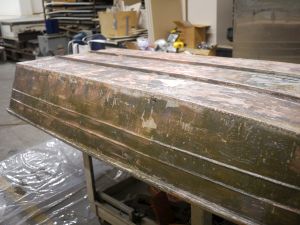 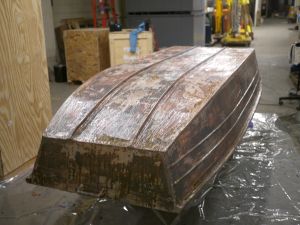 With the goo painted on just about every
surface the process began. We let the whole boat sit
overnight and let the paint stripper do its magic. I
was fairly suspicious, as the stripper had no
volatile scent or eye-burning sensation when nearby.
I put up a sign in case anyone got curious as the
pink goo went to work. With the goo painted on just about every
surface the process began. We let the whole boat sit
overnight and let the paint stripper do its magic. I
was fairly suspicious, as the stripper had no
volatile scent or eye-burning sensation when nearby.
I put up a sign in case anyone got curious as the
pink goo went to work.
|
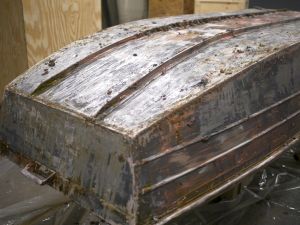 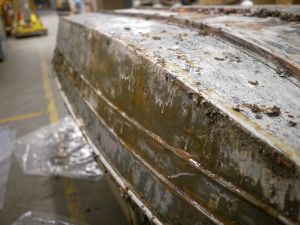 ONE DAY
LATER ONE DAY
LATER
To both me and Sam's surprise, the paint started
peeling off! The goo had worked. Slowly, using a
scraper, sheets of the paint and goo started
coming off, piles of disgusting paint were
everywhere. We ended up going through a box of
gloves |
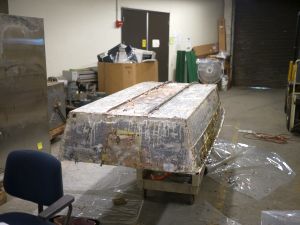 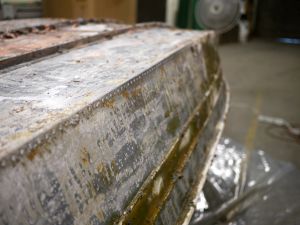 With
a pass of the scraper the goo peeled off. The difference
between the scraped and unscraped are shown on the top
versus the bottom. With
a pass of the scraper the goo peeled off. The difference
between the scraped and unscraped are shown on the top
versus the bottom.
There were some curious parts, we did find particular
buildup of 'stuff' around the rivets. I was convinced it
was, er, 'biologicals' or 'coral' or something, as it
turned out, after we arduously removed most of it, it
was most likely sealing epoxy... So that happened... |
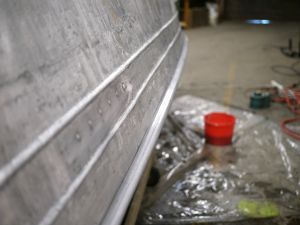 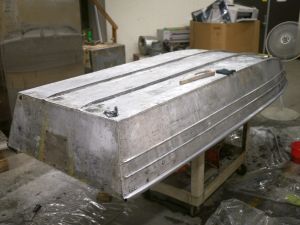 Wire brushes, brillow pads
and grinders, oh my! Wire brushes, brillow pads
and grinders, oh my!
With a lot of hard work and scrubbing the aluminum
started to appear from under the weathered outsides. |
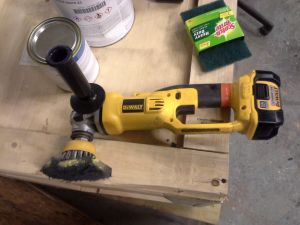 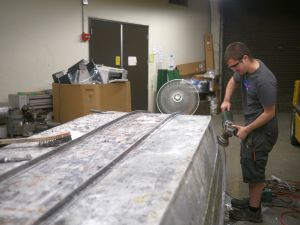 Tools of the trade Tools of the trade
As it turned out, wire brushes attached to angle
grinders are fairly ineffective. While they are coarse,
they also surprisingly get clogged fairly quickly. The
quick solution was 'smush a scotch brite pad into the
wire brush and go to town'. The 120vac angle grinder was
run through a variac to limit the voltage to a more
reasonable ~40 vAC. FRED lent his 18v
dewalt-grinder-of-science and lo, there was some
excellence. The poor battery would get chewed through in
a few minutes. |
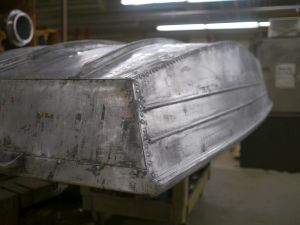 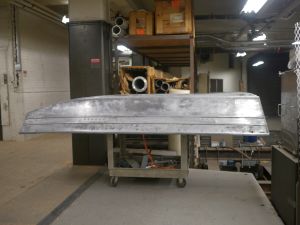 Most
of the crevices and ribs were cleaned by hand, which,
took a while. Finally it was ready for painting prep!
Ratchet strapped boat-to-cart worked phenomenally well. Most
of the crevices and ribs were cleaned by hand, which,
took a while. Finally it was ready for painting prep!
Ratchet strapped boat-to-cart worked phenomenally well.
|
Paint prep
|
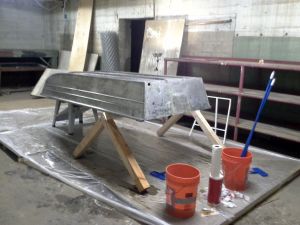 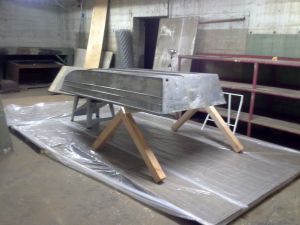 Before painting, the area
was prepped with some plastic sheet, staple hammered
to the floor. A sawhorse was assembled and the boat
was prepped by de-dusting with simple-green and a
boatload of towels. A long 'brush on a stick' worked
really effectively for reaching across and down the
boat. Before painting, the area
was prepped with some plastic sheet, staple hammered
to the floor. A sawhorse was assembled and the boat
was prepped by de-dusting with simple-green and a
boatload of towels. A long 'brush on a stick' worked
really effectively for reaching across and down the
boat. |
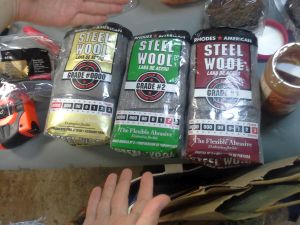 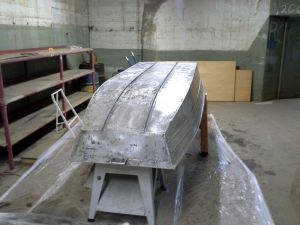 Steel wool was used on
the final cleaning of any areas that still had cruft
left over from the de-painting process. Steel wool was used on
the final cleaning of any areas that still had cruft
left over from the de-painting process. |
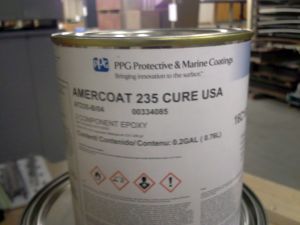 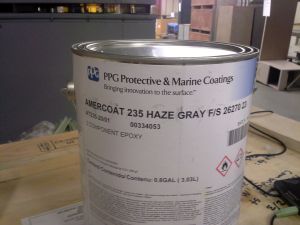 PRIMER
TIME PRIMER
TIME
For a primer, we used
Amercoat 235 2-part epoxy primer. Holy moleys do you
need a respirator to use this stuff. Mix well, really,
really well before using. Both myself and Sam garnered
these [link] and prepped with rollers
and gratuitous amounts of gloves. Note this is proper
marine coating goodness, intended for aluminum hulled
crafts. This was acquired from C.
G Edwards Marine supply over in Boston Ma.
Covering the boat twice consumed roughly 1/3 of the
epoxy. |
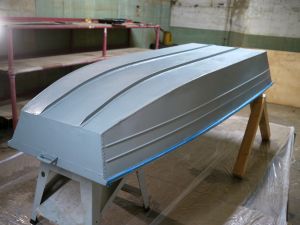 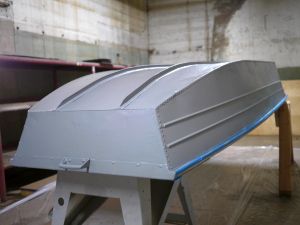 The actual painting
process didn't have too many photos, as, well my
gloves were covered in paint. Here's the first coat
after about a day of drying. Honestly it looked
fantastic. The 'its all the same color' and 'its not
covered in biological stuff' really stuck out. A
second coat was applied about 3 days later to ensure
that all the rivets were completely covered. Note that
the epoxy primer was intended to seal any rivet
related leaks. The actual painting
process didn't have too many photos, as, well my
gloves were covered in paint. Here's the first coat
after about a day of drying. Honestly it looked
fantastic. The 'its all the same color' and 'its not
covered in biological stuff' really stuck out. A
second coat was applied about 3 days later to ensure
that all the rivets were completely covered. Note that
the epoxy primer was intended to seal any rivet
related leaks. |
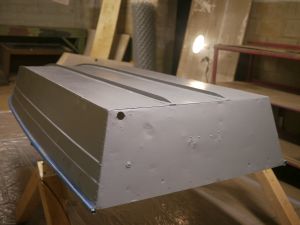 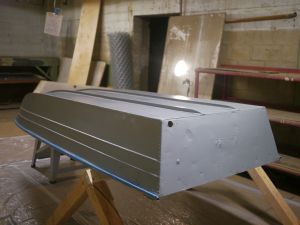 The back was focused on a
bit to ensure the seam between the bottom and sides of
the boat had a decent amount of sealant. The back
plate itself is rather thin with the transom board
removed. Also a hole is present on the back for a
drain plug, or something similar. This was previously
sealed with two blocks of wood and some rtv sealant. The back was focused on a
bit to ensure the seam between the bottom and sides of
the boat had a decent amount of sealant. The back
plate itself is rather thin with the transom board
removed. Also a hole is present on the back for a
drain plug, or something similar. This was previously
sealed with two blocks of wood and some rtv sealant. |
Time for some style
|
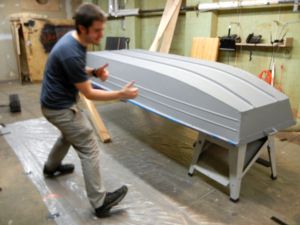 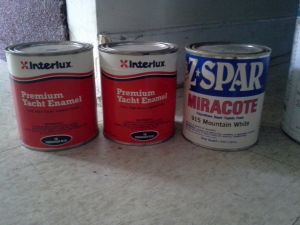 For style, two-tone
painting was the go-to. The place where the
ultra-coating came from suggested yacht enamel. Two
cans of "Endeavor Blue' and one can of 'Mountain
White' was acquired. These came from the same place as
the two-part epoxy and may have been a bit on the old
side. For style, two-tone
painting was the go-to. The place where the
ultra-coating came from suggested yacht enamel. Two
cans of "Endeavor Blue' and one can of 'Mountain
White' was acquired. These came from the same place as
the two-part epoxy and may have been a bit on the old
side. |
 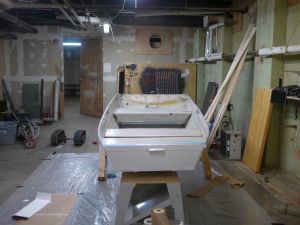 The
hull was coated in Mountain white first. Because this is
a one-part paint, it air-dries. As it turns out,
stagnant air doesn't really allow paint to set. Three
days after painting, we found the white paint still
tacky. Lesson two was then learned, when painting 'out
of a can thats old, its important to mix the frigging
paint. The paint was a bit separated and as a result
took a bit longer to set than anticipated. Finally It
was time for some snazz. The
hull was coated in Mountain white first. Because this is
a one-part paint, it air-dries. As it turns out,
stagnant air doesn't really allow paint to set. Three
days after painting, we found the white paint still
tacky. Lesson two was then learned, when painting 'out
of a can thats old, its important to mix the frigging
paint. The paint was a bit separated and as a result
took a bit longer to set than anticipated. Finally It
was time for some snazz. |
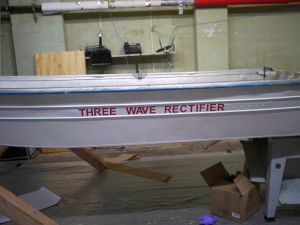 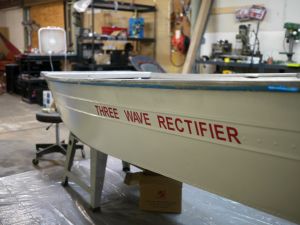 Using the IDC vinyl
cutter, Stencils were born. As this craft was soon to
acquire a 'boatload of power' the name 'THREE WAVE
RECTIFIER" was chosen. The only reason the letters
even came so excellently straight was due to Sam's
attention to detail. Each letter was peeled off a
sheet and eyeballed in place. IT CAME OUT
FANTASTICALLY EXCELLENT. Using the IDC vinyl
cutter, Stencils were born. As this craft was soon to
acquire a 'boatload of power' the name 'THREE WAVE
RECTIFIER" was chosen. The only reason the letters
even came so excellently straight was due to Sam's
attention to detail. Each letter was peeled off a
sheet and eyeballed in place. IT CAME OUT
FANTASTICALLY EXCELLENT. |
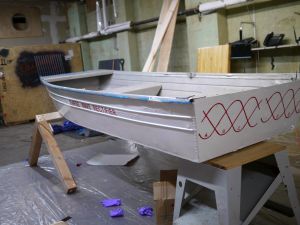 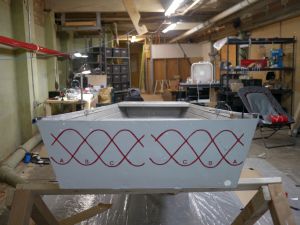 Stenciling
continued with the actual three-waves. Stenciling
continued with the actual three-waves.
This took ~6 sets of
hands to apply, but, steadfastly so, we did it. The
three sinusoidal waves were stickered on the back.
Note that a rear transom plate mounts in the middle of
the rear of the boat and as such there wasnt a need
for the two decals to mate in the middle. |
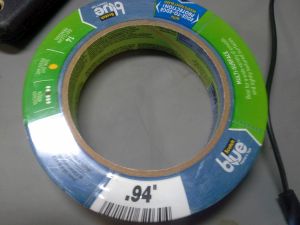 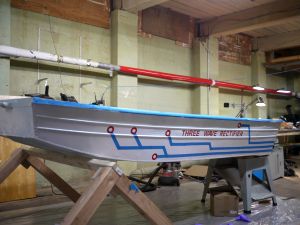 Free hand traces and vias
time! Free hand traces and vias
time!
Using 1" diameter
blue painters tape and some imagination, traces and
vias were added. Because the white paint was still 'a
bit tacky' we went light with the tape, realistically
a firm-er hand may have resulted in a bit more solid
of a trace. The vias were actually more vinyl cut
parts that were manually added to the ends of the
traces. |
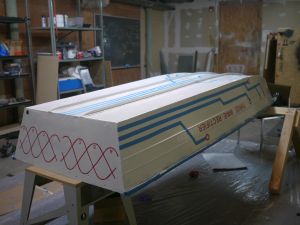 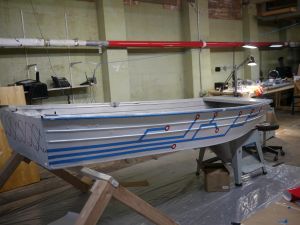 The
traces continue The
traces continue
Along the top and
sides the traces continue.. Clearly a three
dimensional kicad layout happening here
|
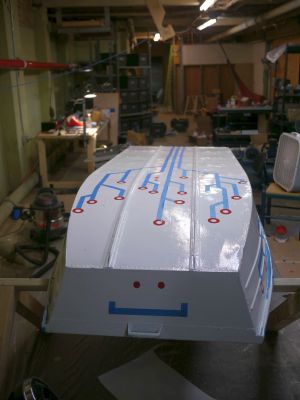 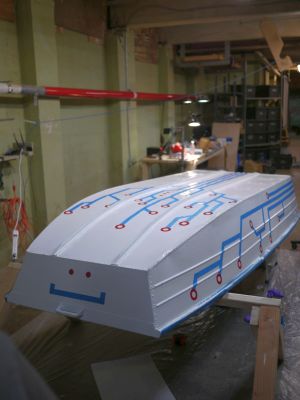 Finally
some finishing touches were added on: Finally
some finishing touches were added on:
The Smiley face was
intended so that when the boat sat atop a vehicle it
would be smiling. When underway in the water the face
itself isnt quite visible.
|
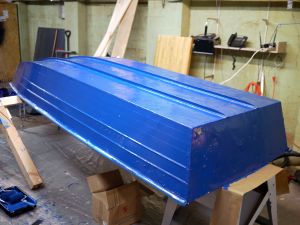 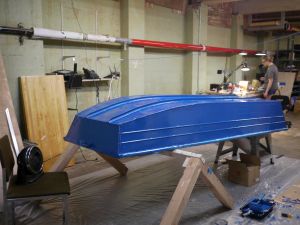 BLUE
PAINT EVERYWHERE BLUE
PAINT EVERYWHERE
Two coats of blue
paint later and the painters tape was barely visible.
|
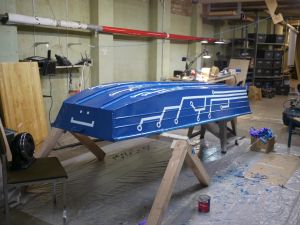 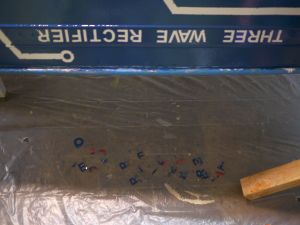 Letters
and decals scattered about the floor Letters
and decals scattered about the floor
While the blue was
tacky, the painters tape and labels were pelled back.
|
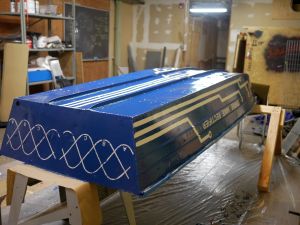 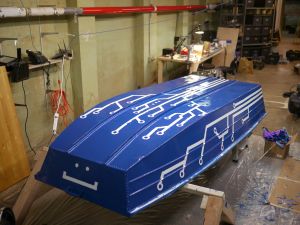 Slowly
the painters tape was peeled back, the vinyl cut vias
were removed and the giant three phase label yanked off.
It was frigging beautiful. A bit more aromatic than I
initially thought it would be, but just frigging
fantastic. Slowly
the painters tape was peeled back, the vinyl cut vias
were removed and the giant three phase label yanked off.
It was frigging beautiful. A bit more aromatic than I
initially thought it would be, but just frigging
fantastic. |
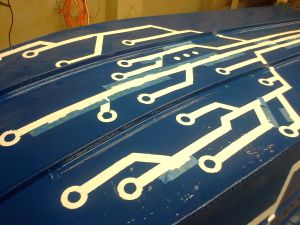 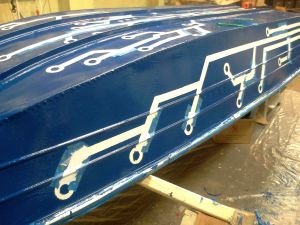 A few days later, after
the blue had fully set, painters tape and hand brushes
were used to clean up any edges that didn't quite come
out as sharp as they could have. It really was taking
shape and looked phenomenal. A few days later, after
the blue had fully set, painters tape and hand brushes
were used to clean up any edges that didn't quite come
out as sharp as they could have. It really was taking
shape and looked phenomenal. |
Hardware
Upgrades
|
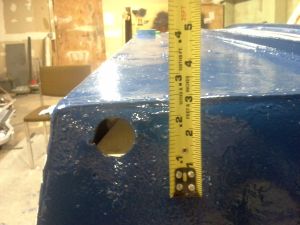 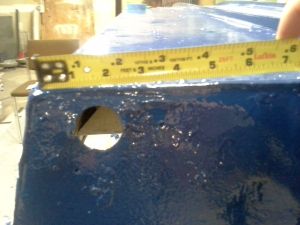 There were a few things
still to do, there was a huge hole that was initially
intended for a drain plug or something similar. After
some quick dimensions and sketching, A cad model was
thrown together There were a few things
still to do, there was a huge hole that was initially
intended for a drain plug or something similar. After
some quick dimensions and sketching, A cad model was
thrown together |
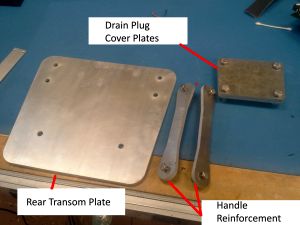 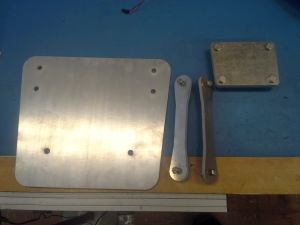 The transom plate was
made of 1/4" thick 5200 series aluminum (for marine
environments) the drain plug covers were made of two
1/8" sheets of aluminum, attached with stainless steel
hex bolts and stainless nuts. I purchased two aluminum
boat handles from [link] intending to use the
reinforcement plates to help transfer any load of the
boat better to the hull, instead of just yanking on
the thin back plate material. The transom plate bolts
were placed to prevent the engine/motor mount from
conflicting with the mounting bolts. The transom plate was
made of 1/4" thick 5200 series aluminum (for marine
environments) the drain plug covers were made of two
1/8" sheets of aluminum, attached with stainless steel
hex bolts and stainless nuts. I purchased two aluminum
boat handles from [link] intending to use the
reinforcement plates to help transfer any load of the
boat better to the hull, instead of just yanking on
the thin back plate material. The transom plate bolts
were placed to prevent the engine/motor mount from
conflicting with the mounting bolts. |
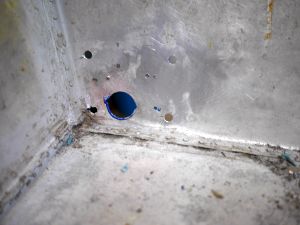 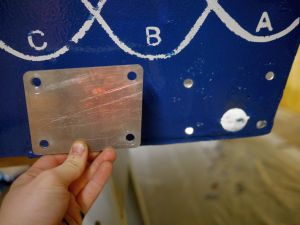 The placement of the
draining hole made this a bit precarious, its very low
in the hull, which made the mounting holes on the
inside plate define the assembly. Pressing the inner
drain plate against the hull and marking holes for
drilling was a bit precarious, but 18v dewalt did the
job dandy. Note that the aluminum plate covers the
drainage hole completely. Do you have the same craft?
here's [design files] and a [dxf] you can submit to
bigbluesaw for a quick duplicate. The placement of the
draining hole made this a bit precarious, its very low
in the hull, which made the mounting holes on the
inside plate define the assembly. Pressing the inner
drain plate against the hull and marking holes for
drilling was a bit precarious, but 18v dewalt did the
job dandy. Note that the aluminum plate covers the
drainage hole completely. Do you have the same craft?
here's [design files] and a [dxf] you can submit to
bigbluesaw for a quick duplicate. |
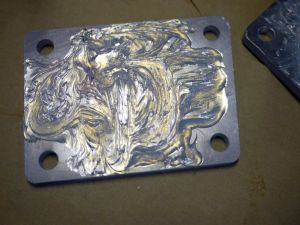 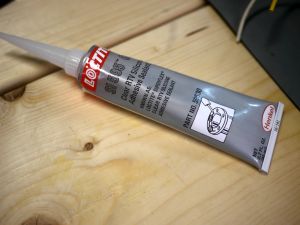 Loctite
RTV was used as the intermediate sealant between the
drain plate and the hull, it was important to let it
start to tack up before setting it in place, and
moreover, not fully torque-ing it while it was in this
state. Loctite
RTV was used as the intermediate sealant between the
drain plate and the hull, it was important to let it
start to tack up before setting it in place, and
moreover, not fully torque-ing it while it was in this
state. |
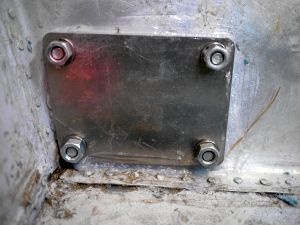 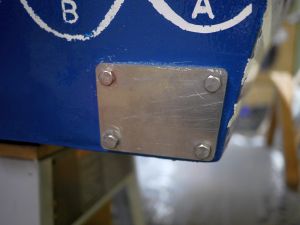 Both
plates were heavily gooped and lightly bolte in place.
Roughly 30 minutes later i fully torqued the plates
together, and they straightened the bottom corner
substantially. Both
plates were heavily gooped and lightly bolte in place.
Roughly 30 minutes later i fully torqued the plates
together, and they straightened the bottom corner
substantially. |
 A
quick 'hold in place' verified the rear transom plate
was ready for mounting as well. I waited until the inner
wooden transom was ready before attaching this plate. A
quick 'hold in place' verified the rear transom plate
was ready for mounting as well. I waited until the inner
wooden transom was ready before attaching this plate. |
Concluding Remarks:
- It is incredibly rewarding repairing contraptions and adding
a flair of personality. I had a great time working with
excellent comrades, who both put up with my antics and paint
fumes while this craft was being reborn.
- Paint is weird, remember to mix, then mix some more and when
you think its completely mixed, mix some more. Forced air
around a freshly painted object will also dramatically increase the
speed of it setting. As The Jume says 'fans are great'.
- Vinyl cutters are fantastic, cutting the vias and the
lettering really made this project pop.
- This couldnt have happened without Sam's attention to
detail, Jume's ability to withstand paint fumes and everyone
else's patience with me beginning sentences with AHOY!
If you
have
questions or comments, ask below or send over an email.
(be
careful, im not responsible for that paint crud stuck
under your fingernails )
Dane.Kouttron
Rensselaer Polytechnic
Institute
Electrical & Electrical
Power
631.978.1650

 Epoxy
time ahoy!
Epoxy
time ahoy!
 The
return of 8' Jon Boat
The
return of 8' Jon Boat

 Before painting, the area
was prepped with some plastic sheet, staple hammered
to the floor. A sawhorse was assembled and the boat
was prepped by de-dusting with simple-green and a
boatload of towels. A long 'brush on a stick' worked
really effectively for reaching across and down the
boat.
Before painting, the area
was prepped with some plastic sheet, staple hammered
to the floor. A sawhorse was assembled and the boat
was prepped by de-dusting with simple-green and a
boatload of towels. A long 'brush on a stick' worked
really effectively for reaching across and down the
boat. 
 Steel wool was used on
the final cleaning of any areas that still had cruft
left over from the de-painting process.
Steel wool was used on
the final cleaning of any areas that still had cruft
left over from the de-painting process. 
 PRIMER
TIME
PRIMER
TIME







